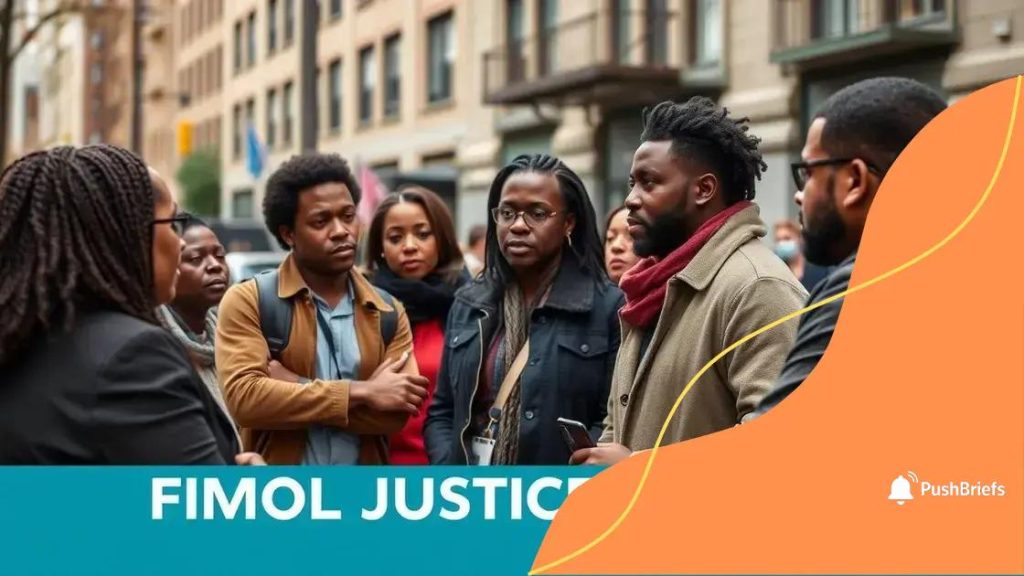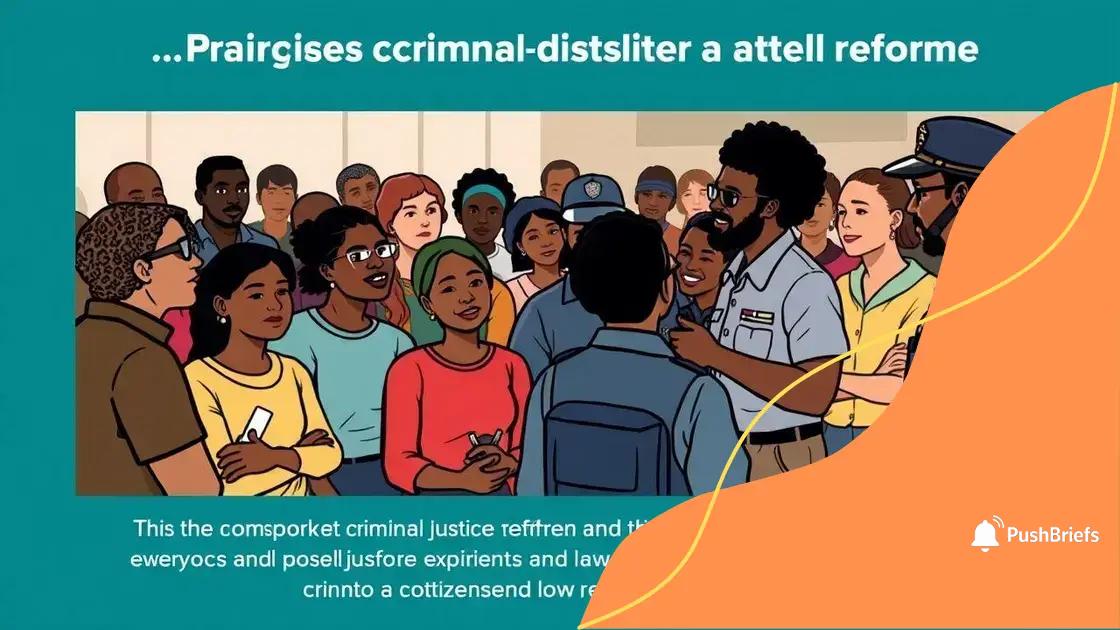Criminal justice reform proposals advanced: what’s next?

Criminal justice reform proposals aim to create a fairer system by addressing issues like sentencing disparities, improving rehabilitation, and enhancing community trust in law enforcement.
Criminal justice reform proposals advanced are creating a stir across the nation. But what does this mean for our communities and legal systems? Let’s dive into the discussion.
Current state of criminal justice
Understanding the current state of criminal justice is crucial for grasping the need for reform. This system has deep roots in our society, impacting lives every day. Yet, many believe it requires significant changes to address various injustices.
Issues Facing the Criminal Justice System
Several key problems affect how the system functions today. These challenges highlight the necessity for reform and raise questions about the fairness and efficacy of our justice system.
- Overcrowding in prisons: Many facilities are filled beyond capacity, leading to dangerous conditions.
- Disparities in sentencing: Studies show that minority groups often receive harsher sentences.
- Access to legal representation: Many individuals cannot afford quality legal help, impacting their cases.
- Recidivism rates: High rates of reoffending indicate that current rehabilitation efforts may be insufficient.
These issues are not just statistics; they represent real people affected by a system that often seems unjust. For example, consider the impact of mandatory minimum sentences, which can lead to unnecessarily harsh penalties for non-violent offenses, disproportionately affecting minority communities.
The Role of Public Opinion
Public opinion plays a pivotal role in shaping policies within the criminal justice system. As awareness of these issues grows, so does the demand for change. People are becoming more informed about how the system operates and are calling for transparency and accountability.
Awareness campaigns and community activism are vital. They empower citizens to advocate for reforms that address the fundamental flaws within the system. This grassroots movement is crucial in ensuring that legal changes reflect the needs of the community.
Moreover, collaboration between local governments, non-profits, and community members can lead to innovative solutions that address the root causes of crime and inequity.
Key proposals for reform
Exploring the key proposals for reform in the criminal justice system reveals the deep desire for change among advocates and communities alike. These proposals aim to create a fairer, more just system.
Major Reform Proposals
Several significant proposals have emerged to address the shortcomings of the current system. By focusing on fairness and rehabilitation, these reforms aim to reshape how justice is served.
- Sentencing reform: This proposes adjustments to mandatory minimums and harsh sentencing guidelines to ensure that punishments fit the crimes.
- Decriminalization of certain offenses: Advocates suggest that non-violent offenses, particularly related to drug use, should be decriminalized to reduce the prison population.
- Investment in community services: Increasing funding for mental health and addiction services can prevent crime and support rehabilitation for offenders.
- Police accountability measures: This includes establishing stricter oversight of police conduct and ensuring transparency in practices.
These proposals are just the starting point in the journey toward a better system. Each proposal focuses on different aspects of the justice continuum, intending to make it more equitable for all.
Community Involvement
Community involvement is crucial in shaping these proposals. When individuals and groups engage with local government and law enforcement, they can voice their concerns and suggestions for improvement. This collaborative approach helps ensure that reforms reflect the needs and experiences of those affected by the justice system.
Education about the implications of these proposals is also essential. When people understand how reforms can impact their communities, they become more invested in advocating for change.
Community impact of proposed changes

The community impact of proposed changes in the criminal justice system is significant. These changes can transform how individuals interact with law enforcement and the judicial process. Understanding this impact helps to identify the benefits of reform.
Improved Public Trust
One potential effect of reform is an increase in public trust towards law enforcement. When communities see efforts to make the justice system fairer, they often feel safer and more respected. This trust leads to better cooperation between the community and law enforcement, which can enhance public safety.
- Increased reporting of crimes: Trust encourages citizens to report crimes and provide information to the police.
- Community engagement: Enhanced trust can lead to greater community involvement in programs aimed at public safety.
- Positive interactions with police: When the community feels respected, interactions with law enforcement tend to be more constructive.
This alignment can help reduce tensions that may otherwise result in conflict. Through transparency and accountability, communities can feel they are part of the solution rather than adversaries.
Support for Rehabilitation
The proposed changes not only affect how communities view police but also how they approach rehabilitation. A focus on rehabilitation over punishment can lead to extensive community benefits. Many individuals who face criminal charges come from challenging backgrounds. Investing in rehabilitation means investing in their futures.
When rehabilitation programs are implemented, communities experience several positive shifts. For instance, offering skills training and job placement services helps lower recidivism rates. When individuals leave prison with skills and support, they are less likely to reoffend.
Additionally, families benefit when their loved ones receive the support they need. Reduced crime rates contribute to safer neighborhoods and improved quality of life. This holistic approach not only addresses the symptoms of crime but also goes to the root causes, creating lasting change.
Challenges in implementation
The challenges in implementation of criminal justice reforms are significant and multifaceted. While the goals of reform are noble, the actual execution can be quite complex. Various obstacles can arise that hinder effective changes.
Resistance from Law Enforcement
One major challenge is resistance from some law enforcement agencies. These departments may view reform as a threat to their authority and methods. When officers feel attacked or undermined, they may resist changes intended to improve the system.
- Fear of reduced funding: Some agencies worry that reforms could lead to budget cuts.
- Cultural resistance: A long-standing culture within some departments can hinder the acceptance of new practices.
- Concerns about safety: Officers might believe that reforms can lead to increased danger in their job.
Building trust and collaboration between law enforcement and communities is essential. Establishing open lines of communication can help mitigate these fears, allowing for smoother implementation.
Funding and Resources
Another significant hurdle is the availability of funding and resources. Implementing reforms often requires investment in training, new technologies, and community programs. Without proper funding, even the best proposals may fall short of expectations.
Programs aimed at rehabilitation or community outreach also need financial backing to succeed. When budgets are tight, prioritizing these initiatives can be difficult. It is vital for communities and lawmakers to advocate for funding that supports these necessary changes.
Furthermore, the lack of resources can limit the effectiveness of the reforms. Without access to mental health services, educational programs, and job training, the potential benefits of reform will be diminished. Investing in these areas is crucial for sustainable improvements.
Future outlook on justice reform
The future outlook on justice reform is filled with potential and challenges. As society evolves, so too does the conversation around criminal justice. Many believe reforms can lead to a more equitable and fair system.
Growing Awareness and Advocacy
Awareness around issues in the criminal justice system is increasing. More people are recognizing the need for change, leading to greater advocacy. Grassroots movements are gaining momentum, and people are calling for transparency and accountability in law enforcement.
- Community engagement: Increased involvement from citizens can drive change.
- Educational initiatives: Teaching the public about justice issues can foster understanding and support for reforms.
- Collaborative efforts: Partnerships between communities and law enforcement are essential for effective reforms.
As communities advocate for their rights, they can influence local and national policies. This collective voice is crucial in shaping the future of justice reform.
Technological Innovations
Technology also plays a vital role in the future of justice reform. Innovations can assist in monitoring and improving law enforcement practices. For example, body cameras can enhance accountability, while data analytics can help identify patterns in crime.
Furthermore, advancements in rehabilitation programs, including virtual therapy and education platforms, can provide support to those in need. These innovations allow for personalized approaches to justice that can lead to better outcomes.
The integration of technology can streamline processes and create a more efficient justice system. When used correctly, technology can act as a tool in reducing bias and improving the overall fairness of the system.
FAQ – Frequently Asked Questions about Criminal Justice Reform
What are the main goals of criminal justice reform?
The primary goals are to increase fairness, reduce recidivism, and enhance community safety through effective rehabilitation.
How can community involvement influence justice reform?
Engaging communities helps ensure that reforms address real needs and can drive meaningful changes in the system.
What role does technology play in justice reform?
Technology can enhance transparency, improve accountability, and aid in rehabilitating offenders.
What challenges do reforms face in implementation?
Resistance from law enforcement, funding limitations, and cultural barriers are key challenges that may hinder effective reform.
